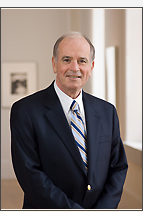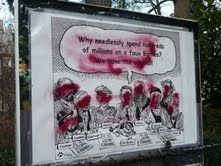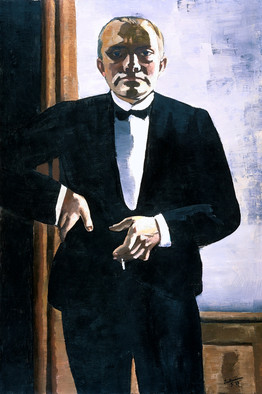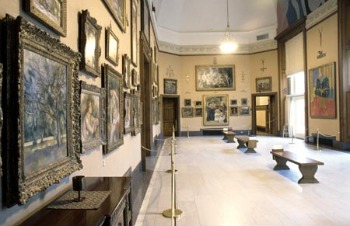The art world and much of the political world got all tangled up over the past week about the Hide/Seek controversy at the National Portrait Gallery, but I have to say that I’ve not been thrilled with the level of discourse. Much of it has been knee-jerk, a “whose ox is gored” and “where you stand depends on where you sit” stance that sheds little light on anything and does not advance the ball.
 In that vein, it troubles me that the Association of Art Museum Directors — issuing what many described as an unusally tough statement on Friday — threw around of the term “censorship.” As in:
In that vein, it troubles me that the Association of Art Museum Directors — issuing what many described as an unusally tough statement on Friday — threw around of the term “censorship.” As in:
More disturbing than the Smithsonian’s decision to remove this work of art is the cause: unwarranted and uninformed censorship from politicians and other public figures, many of whom, by their own admission, have seen neither the exhibition as a whole or this specific work.
I commend the group for acting swiftly, but I beg to differ with that comment.
It’s unclear to me, having read much but not all of the reporting on the subject, whether NPG director Martin E. Sullivan (below) acted alone in removing the “offending” piece (not having seen it, I have no idea if I would be offended) or whether he was ordered to by G. Wayne Clough, Secretary of the Smithsonian.
 If he acted alone, there was no censorship — and AAMD’s beef is with Sullivan, seems to me. If Clough ordered it, one could make a case that it was censorship — though there was no prior restraint.
If he acted alone, there was no censorship — and AAMD’s beef is with Sullivan, seems to me. If Clough ordered it, one could make a case that it was censorship — though there was no prior restraint.
To imply, as AAMD does, that incoming Speaker of the House John Boehner and incoming Majority Leader Eric Cantor practiced censorship is misconstruing their protests. Yes, they have leverage over the Smithsonian budget, but they can’t control it on their own — what they can do is stir the nation, yet again, against art.
Yet they, and others who called the work offensive, are just as entitled to free speech as was artist David Wojnarowicz. The very next line in the AAMD statement says this:
The AAMD believes that freedom of expression is essential to the health and welfare of our communities and our nation.
If so, it’s free speech for all, including those one vehemently disagrees with — isn’t it? Their right to free speech should have been acknowledged in the statement. The art world does not cover itself in glory by implying it is sacrosanct and that art (especially political art, which this was) can not be criticized.
It’s also unclear to me whether Sullivan himself saw the entire 4-minute video piece in question, including the 11 seconds in questions, before the controversy. If he did not, he set himself up for criticism.
Sullivan’s short statement about removing the work may have been designed to put an end to the controversy, but it leaves open exactly what happened.
Call me conservative, but I do believe that national institutions like the Smithsonian should play by slightly different rules than museums that draw no funds from the public purse. That’s not to say controversial art should be avoided — how could it be? — but that costs must be weighed. Trying to say, as the NPG did, that exhibitions are privately funded, while the staff and buildings are not, is no excuse. (Logically, that would lead to firing the curator…)
I have another question that I have yet to see addressed: the NPG show has been on view since October, but it was only last week that the flareup erupted — and not on Fox News. I believe it came first on CBS. CNS [Please see comment from Michael Botwinick below]. Who, in particular, is trying to re-ignite the culture wars? And why is the art world playing into his or her (actually probably “their”) hands?
Photo Credit: Courtesy of the NPG (bottom)

 Last night, someone defaced the newest sign, which was on a fence, with red paint. It showed Dr. Albert C. Barnes, surrounded by many artists whose work he collected, and read: “Why spend hundreds of millions on a faux Barnes when we have the original?” Another sign, on their lawn, which read “Join the Fight to Save the Barnes” had been torn away and thrown over the fence of the Barnes Foundation, which is directly across the street, Herman says.
Last night, someone defaced the newest sign, which was on a fence, with red paint. It showed Dr. Albert C. Barnes, surrounded by many artists whose work he collected, and read: “Why spend hundreds of millions on a faux Barnes when we have the original?” Another sign, on their lawn, which read “Join the Fight to Save the Barnes” had been torn away and thrown over the fence of the Barnes Foundation, which is directly across the street, Herman says.
 In fact, I’ve been wondering why this hasn’t happened before: The recession is causing state public officials to review the commitments that would be funded by a $1 billion bond issue, and they include the Barnes’s move.
In fact, I’ve been wondering why this hasn’t happened before: The recession is causing state public officials to review the commitments that would be funded by a $1 billion bond issue, and they include the Barnes’s move.